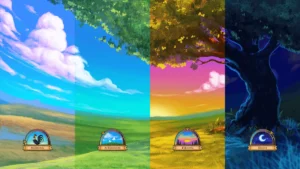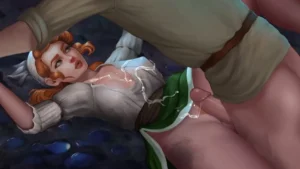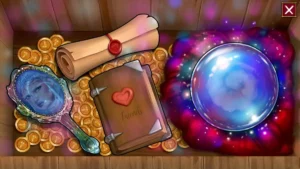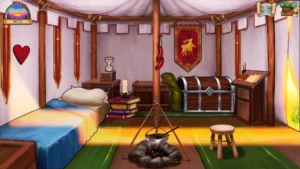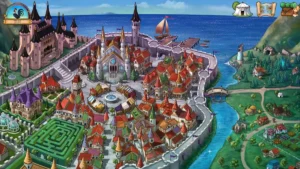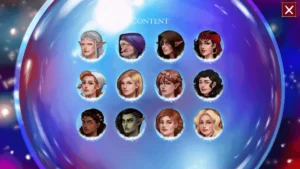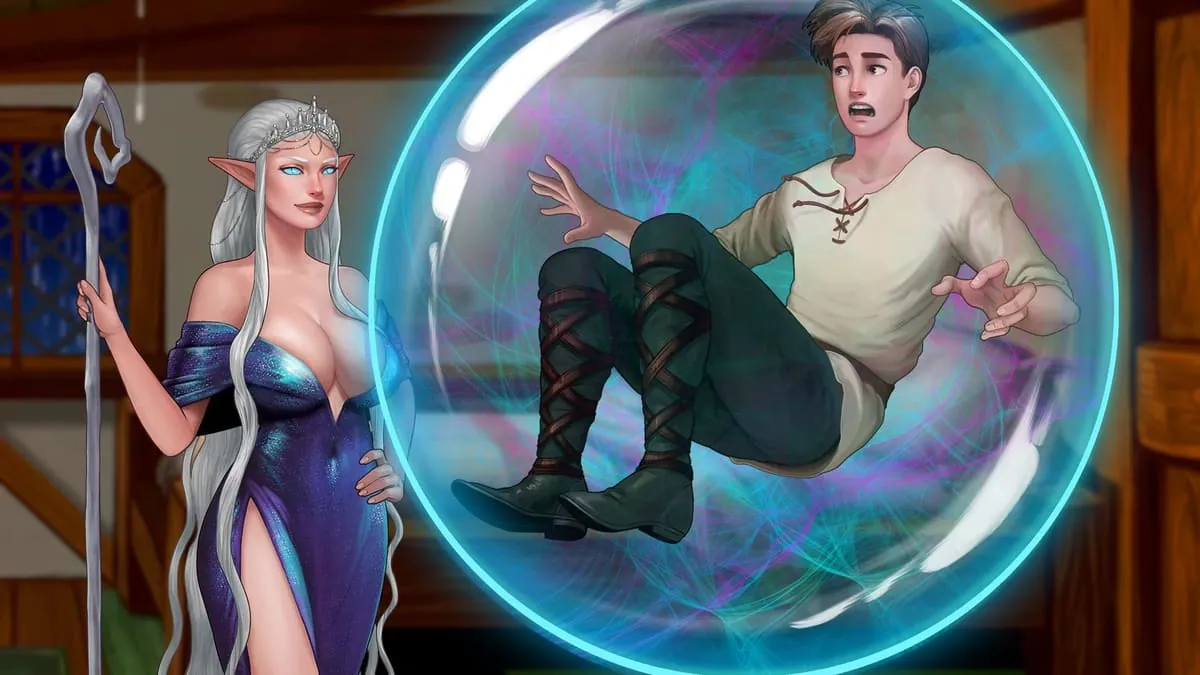
What a Legend!
Play What a Legend!
What a Legend! review
Explore the immersive fantasy adventure combining visual novel storytelling with sandbox gameplay
What a Legend! stands out as a unique point-and-click adventure that blends visual novel storytelling with sandbox mechanics in a medieval fantasy setting. This game offers players an engaging narrative experience where choices matter, featuring multiple storylines centered around a young protagonist navigating encounters with various characters while pursuing a mission to stop an evil tyrant. With its combination of persuasion mechanics, magical elements, and moral choices, What a Legend! delivers a distinctive gaming experience that appeals to players seeking narrative-driven adventures with meaningful player agency and multiple endings.
Gameplay Mechanics and Core Features
Alright, let’s get straight into the good stuff. If you’re like me, you’ve probably loaded up a game expecting a grand adventure, only to find yourself stuck on a linear path with little room to truly express yourself. 😩 That’s exactly why discovering What a Legend! felt like a breath of fresh air. This isn’t just another fantasy romp; it’s a masterful blend of genres that respects your intelligence and rewards your curiosity. The core What a Legend! gameplay mechanics are a delicious cocktail of classic adventure, open-ended exploration, and meaningful decision-making. 🍹
I remember my first session—I spent a solid hour just clicking around the starting village, not because I was stuck, but because every nook and cranny held a potential secret, a funny interaction, or a clue to a larger mystery. This game understands that the journey is just as important as the destination. So, grab your virtual walking stick, and let’s dive deep into the systems that make this interactive storytelling game so unforgettable. 🧙♂️
Point-and-Click Adventure Mechanics 🖱️
At its heart, What a Legend! is a love letter to the golden age of point-and-click adventure game classics. The interface is beautifully simple: you look, you interact, and you combine. Your cursor is your primary tool, and the world reacts to your curiosity. See a suspicious-looking book on a shelf? Click it. Notice a glint from a drainpipe? Investigate it. This intuitive system makes the world feel tactile and alive.
The beauty of this approach is how it seamlessly integrates with the other game systems. You’re not just collecting random junk; you’re gathering potential solutions to puzzles that are deeply woven into the choice-driven narrative. For instance, early on, you might need to find a way to get a key from a grumpy innkeeper. The classic point-and-click logic applies: you see he’s fond of his ale, so you find a way to distract him or swap his drink. Successfully navigating these scenarios often relies on the persuasion mechanics game elements, creating a satisfying loop of observation, inventory management, and social interaction.
Pro Tip: Don’t just click on everything once. Characters and objects often have multiple dialogue options or interactive states. Revisiting an area after a major story beat can reveal entirely new possibilities!
Here’s a quick breakdown of how the core mechanics feed into each other to create a rich player experience:
| Core Mechanic | Primary Function | Impact on Player Experience |
|---|---|---|
| Point-and-Click Exploration | World navigation, item collection, and environmental interaction. | Fosters a sense of discovery and player-led pacing. You control how thoroughly you explore. |
| Dialogue Trees | Character interaction and relationship building. | Creates deep immersion and emotional investment in the story and its characters. |
| Inventory Puzzles | Problem-solving using collected items and logic. | Provides classic adventure game satisfaction and intellectual challenge. |
| Persuasion & Magic | Influencing NPCs and altering the game world. | Adds a layer of strategic depth and personal power fantasy to social encounters. |
The magic system 💫 is a perfect example of this integration. It’s not a separate menu; it’s something you discover, learn, and apply through the point-and-click interface. Finding a magical scroll allows you to cast a spell on a character or object, opening up paths that were previously blocked. It turns the traditional “use key on door” puzzle into “use charm spell on guard” or “use reveal spell on hidden glyph,” making you feel genuinely clever.
Sandbox Elements and Player Freedom 🌍
Now, this is where What a Legend! truly separates itself from the pack. While it has the soul of a point-and-click adventure, it possesses the heart of a game rich with sandbox game elements. This isn’t a theme park ride where you’re shuffled from one set piece to the next. It’s a sprawling, living world that invites you to set your own goals and make your own fun. You have an overarching quest, sure, but how you choose to tackle it—or when you choose to tackle it—is largely up to you.
I learned this the hard way when I was supposed to be investigating a missing person case. Instead, I got sidetracked helping a local merchant establish a rival business, which involved a whole side-quest of gathering resources, sabotaging the competition (ethically… mostly 😉), and negotiating trade routes. Hours flew by, and it felt like a complete, self-contained story that I had initiated. This emergent gameplay is the direct result of its robust sandbox game elements.
The player freedom manifests in several key ways:
- Non-Linear Exploration: 🗺️ The game world is open to you from relatively early on. You can often travel between major locations at will, discovering side quests and secrets that are entirely optional but richly rewarding.
- Multiple Solution Pathways: Most challenges, especially social ones, can be solved in more than one way. You can use brute charm, clever deception, magical influence, or good old-fashioned bribery. This flexibility ensures that your playstyle is always valid.
- Character Specialization: As you play, you can lean into different aspects of your character. Focusing on building your charm and persuasion will lead to a very different experience than a playthrough where you master offensive or utility magic.
This freedom is deeply tied to the game’s other systems. Your choices in the choice-driven narrative open up or close off areas of the sandbox. Your success with the persuasion mechanics game can unlock new allies or resources that further expand what you can do. It’s a glorious, self-reinforcing cycle of cause and effect that makes the world feel truly responsive to your presence.
Choice-Driven Narrative System 🎭
Forget those “illusions of choice” you find in lesser games. In What a Legend!, your decisions carry real, tangible weight. The choice-driven narrative is the central nervous system of the entire experience, connecting the point-and-click exploration and sandbox freedom to create a story that is uniquely yours. Every conversation, every moral dilemma, and every alliance you form writes a new line in your personal legend.
The system goes far beyond simple “Good vs. Evil” sliders. It’s a complex web of character affections, faction reputations, and world states. I was genuinely shocked when, midway through my second playthrough, a character I had casually helped in the first hour showed up to return the favor in a major way, completely altering the course of a late-game event. That’s the power of a truly reactive interactive storytelling game.
Let’s break down the key components:
Persuasion Mechanics Game: 🗣️
This is your primary tool for shaping social encounters. It’s not just about picking the “nice” option. You have to read the situation and the character. Are they vain? Use flattery. Are they greedy? Offer a trade. Are they suspicious? Employ logic and honesty. The game presents you with a wheel or list of persuasion types, and choosing the right one based on your understanding of the NPC is incredibly satisfying. Succeeding often unlocks new quests, information, or romantic avenues, while failing can sometimes lead to unexpectedly fun and chaotic outcomes.
The Corruption System: ⚫
This is a fascinating layer on top of the standard narrative choices. Certain actions, like using dark magic, making selfish decisions, or indulging in morally questionable activities, will slowly increase your corruption level. This isn’t just a number; it visibly alters how certain characters perceive you, can unlock unique dialogue and questlines, and even changes some of the visual effects of your magic. It’s a brilliant way to reflect your character’s moral descent (or ascent, if you avoid it) without being overly punitive.
The Multiple Endings System: 🔮
This is the grand finale of your choice-driven narrative. The multiple endings system in What a Legend! is not just about a final choice before the credits roll. It’s the cumulative result of hundreds of decisions you’ve made throughout your journey. Who did you ally with? Which friendships did you nurture? Which romances did you pursue? How did you resolve major conflicts? All of these threads are woven together into a final epilogue that details the fate of the world and its characters.
My first ending was a bittersweet victory where I saved the kingdom but lost the trust of a close friend. My second, where I focused on building personal relationships over political power, resulted in a smaller-scale but much more personally satisfying conclusion. This multiple endings system provides immense replay value, as you’ll constantly be wondering, “What if I had done that instead?” 🤔
Ultimately, the genius of What a Legend! gameplay mechanics is how they refuse to work in isolation. The point-and-click adventure gives you the tools, the sandbox gives you the playground, and the choice-driven narrative gives you the reason to care. It’s a symphony of interactive systems that celebrates player agency above all else, making it one of the most engaging and personal interactive storytelling game experiences available today. Your legend is waiting to be written—so what are you going to do? ✨
What a Legend! delivers a compelling blend of point-and-click adventure gameplay with meaningful narrative choices in a richly detailed medieval fantasy world. The game’s strength lies in its combination of sandbox exploration, character-driven storytelling, and consequence-based decision-making that encourages players to experience multiple playthroughs. Whether you’re drawn to the intricate character relationships, the branching narrative paths, or the satisfaction of discovering all available endings, What a Legend! offers substantial content that rewards engagement and experimentation. For players seeking an adventure where their choices genuinely shape the story and character outcomes, this game provides an immersive experience that stands out in the adventure game genre.





